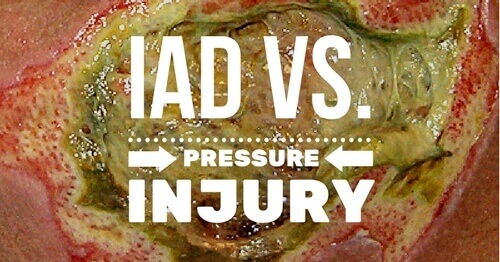How to know the difference between Incontinence Associated Dermatitis (IAD) and pressure injury.
As wound care clinicians, we treat our patients to the best of our ability and heal wounds – that’s what we do. But unfortunately, even under the best of circumstances, facility-acquired pressure injuries happen. And we have to document them … because again, that’s what we do.
So then it would stand to reason that no one would ever purposely document this type of pressure injury without cause, right? So here is the big question of the day: why is it that Incontinence Associated Dermatitis (IAD) is often documented as a Stage 2 pressure injury? We’ve got your answer.
The truth about pressure injuries and staging
We know that any staged skin lesion, by definition, is an area of skin disturbance caused by pressure, and according to the National Pressure Ulcer Advisory Panel, only pressure injuries should be staged. We also know that once any skin lesion is staged, you might find yourself sitting on the “hot seat” – having to defend the development of this new wound. And since part of our job is to prevent pressure injuries, staging areas like this puts us on the defensive when we don’t have to be. The truth: unnecessary staging could lead to charges of inadequate assessment.
Let’s take a closer look
So how do we keep from putting ourselves in such an uncomfortable situation? First, let’s review the difference between these two types of lesions.
Incontinence Associated Dermatitis (IAD)
- IAD is a form of Moisture Associated Skin Damage (MASD), and is defined as inflammation of the skin from prolonged exposure to urine and stool.
- This is usually seen in conjunction with friction and/or chemical and/or bacterial factors – they work together to cause IAD.
- The skin injury that results is always partial thickness in nature.
- You may see some loss of epidermis and superficial dermis leading to a partial thickness wound, but these are not pressure injury.
- These are moisture related injuries, and should never be staged.
Pressure Injuries
- Pressure injuries are caused by unrelieved pressure or shearing forces (which is not what happens in the case of IAD).
When IAD becomes a Pressure Injury
Even though we are talking about two distinct lesions, there are times when IAD converts to a pressure injury. Here’s what you need to know:
- A previously identified IAD must be considered a pressure injury when you see new evidence of full thickness and damage below the dermis (slough, eschar, and granulation tissue are good examples).
- This indicates that the deeper acting forces of pressure and shearing are present (read more about friction vs. shearing here).
- You cannot damage the subcutaneous layer and below by moisture alone.
- Remember – moisture damage to the skin can only be partial thickness.
Do you see evidence of full thickness injury? That means there was ischemic damage that took place and it’s no longer considered IAD, it’s considered a pressure injury. So it’s time to stage it and get to work healing it.
The importance of pressure injury risk assessment
Under such circumstances, this would be considered a facility acquired pressure injury. Hopefully, your patient was previously identified as being at risk for pressure injury development, and prevention interventions are already in place.
Once staging happens, it’s time to go back and do another full assessment of your patient and the wound, and put in place both the proper treatment plan and more advanced prevention interventions. Moving forward, all incontinent patients should be considered at risk for skin breakdown. In other words, implement a care plan to prevent IAD and pressure injury from the get-go.
What do you think?
We’d appreciate hearing about your own experiences with staging IADs, versus true pressure injuries. Do all clinicians in your setting know how to tell the difference between these two types of wounds? Do you feel you have adequate interventions in place for IAD patients? And what are your biggest challenges in treating these patients and assuring proper identification? Please leave your comments below.
Wound Care Education Institute® provides online and onsite courses in Skin, Wound, Diabetic and Ostomy Management. Eligible clinicians may sit for the prestigious WCC®, DWC® and OMS national board certification exams through the National Alliance of Wound Care and Ostomy®(NAWCO®). For details, see wcei.net.
DISCLAIMER: All clinical recommendations are intended to assist with determining the appropriate wound therapy for the patient. Responsibility for final decisions and actions related to care of specific patients shall remain the obligation of the institution, its staff, and the patients’ attending physicians. Nothing in this information shall be deemed to constitute the providing of medical care or the diagnosis of any medical condition. Individuals should contact their healthcare providers for medical-related information.
What do you think?

